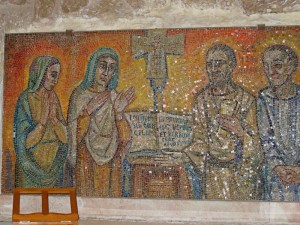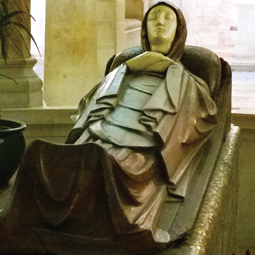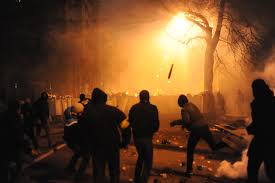
Visiting the Church of the Nativity in Bethlehem was one of the highlights of my trip to the Holy Land, which took place this past May, 2014. I was traveling with a group of journalists from the Catholic Press Association on a whirlwind tour hosted by the Israel Ministry of Tourism. I wanted to see for myself the cave in which the Blessed Virgin Mary gave birth to the Christ Child, and where Joseph and Mary held their Son for the very first time. I wanted to examine the spot that has for centuries been so quaintly portrayed on Christmas cards throughout the world. I wanted to see the Grotto of the Nativity.
The Church of the Nativity itself is amazing, and our group spent some time in the upstairs of this historic church that had been commissioned by St. Helena in 326 A.D. and dedicated in 339 A.D. the church, with its octagonal floor plan, is built directly above the Grotto of the Nativity. Parts of the original (and astounding) floor mosaic are still visible and most of the nave’s 44 columns are from the original structure.
There are four altars in the basilica: the main altar on the east end and the Altar of Circumcision on the south (both property of the Greek Orthodox Church), and the Altar of the Three Kings on the north side of the high altar and the Altar of the Virgin Mary in the north apse (both property of the Armenian Catholic Church).
It’s all oh-so ornate, with gilded angels, icons, stars, lamps, and chandeliers. Our Roman Catholic churches in the United States seem rather bland in comparison. The ornate decorations and the exceptional vigilance of the custodians – they really kept their eyes on the tourists – were visible testimony of the holiness of this place. At one point, I really had to chuckle to myself, because one particular Greek Orthodox priest seemed absolutely perturbed by the influx of visitors. Let’s just say that the look on his face demonstrated his unhappiness. On the other hand, I could understand his concern because there really was quite a bit of commotion and not a whole lot of prayer fullness among the visitors.
I have to admit that my attention span for the church itself was limited; I was too excited to see the Grotto of the Nativity. As we made our way to the grotto’s entrance, we were told that it was closed. There had been a fire in the grotto the night before and the site was under investigation by the Bethlehem police. Arson was suspected. Our tour guide explained that we were Catholic journalists from the United States and tried to gain entry for us. After some deliberation, it was agreed that one member of our party would be allowed to enter the grotto briefly and under supervision. My heart sank! I was toward the front of the group, and was hoping the parentheses praying) that I would be chosen. But the colleague in line in front of me was chosen – a very kind man and accomplished professional who I truly respected. He looked back at me and hesitated. I honestly thought that he was the best suited of all of us, and so I encouraged him to go on in. He had better equipment and more experience than any of us and so he had the better chance to get some really good shots and information.
As happened to me so many times while in the Holy Land, God rewarded a missed experience with one that touched my heart as deeply. In Bethlehem, this was the cave of St. Jerome. The cave is nestled under the Church of St. Catherine, which is annexed to the Church of the Nativity and is the property of the Roman Catholics. St. Jerome, in ardent desire to be as close to the birthplace of Christ as possible, spent 30 years in this two-room underground study, translating the Scriptures from Hebrew and Greek into Latin. He was buried in an adjacent cave, along with Sts. Eusebius, Paula, and Eutochium. St. Jerome’s remains were later taken to Rome.
I completely understood how St. Jerome must have felt. If I couldn’t be in the spot Jesus was born, then I wanted to be as close to it as possible. And I was. I was just on the other side of the wall from it. Overcome with emotion, I began to ramble a silent prayer to St. Jerome, asking him to intercede for me in obtaining all the graces possible from this holy place. Then, I felt a sudden inspiration, almost as if St. Jerome himself were speaking to me. It’s not your feet, but the longing in your heart that puts you in Jesus’s birthplace.
I’m back in St. Jerome’s cave now, as the Christmas cards start arriving with their lovely and placid Nativity scenes and their messages of hope and joy. It does sting my heart a little, because it rekindles my disappointment in not having seen the Grotto of the Nativity for myself. Still, I’m grateful for having been in Bethlehem at all, and especially grateful for the beautiful message I received from St. Jerome. These days I’m again praying to St. Jerome.
I’m asking him to see to it that although my feet can’t put me in Jesus’s birthplace, my heart will.











